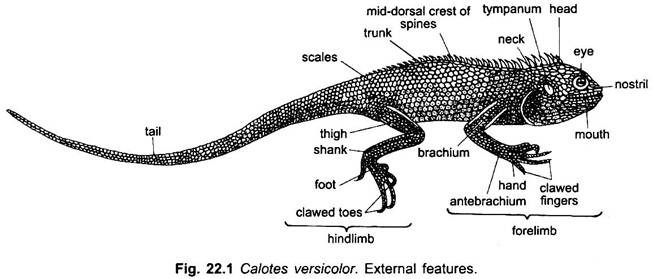In this article we will discuss about the external morphology of garden lizard with the help of suitable diagrams.
Shape, Size and Colour:
Body is elongated, slender, lizard-like and divisible into head, neck, trunk and tail. Male is brightly coloured, golden yellow with a greenish tinge. Throat is scarlet red, often with a black transverse bar. Female is not so brightly coloured. Male is larger and stronger than female, measuring about 35 cm in length including tail (Fig. 22.1).
Head:
The head is large and somewhat pyramidal in shape with a short conical snout which bears a wide, slit-like aperture, the mouth running round the anterior border of the head and a pair of small external nares situated above the anterior extremity.
ADVERTISEMENTS:
At the sides of the head are the eyes, each provided with upper and lower opaque, movable eyelids and with a transparent third eyelid or nictitating membrane, which, when withdrawn, lies in the anterior angle of the orbit. Behind the eye is a circular patch of skin-the tympanic membrane somewhat sunk below the general level of the skin.
Trunk:
Head is connected with the trunk with a short neck. The trunk is elongated, strongly convex dorsally, laterally compressed and flattened ventrally. At the junction of trunk and tail, on the ventral surface is a slit-like transverse aperture, the cloacal aperture.
The trunk bears two pairs of limbs. Each forelimb has an upper-arm or brachium, the forearm or antebrachium, the hand or manus and five horny clawed digits; while each hindlimb comprises the thigh or femur, shank or crus, foot or pes and five clawed digits, of which the hallux or first is the smallest.
Tail:
Tail is cylindrical, tapering showing alternate dark and light annuli and is nearly twice as long as the head and trunk together. In adult male the base of tail just behind the cloacal aperture becomes quite swollen due to hemipenes.
Skin and Exoskeleton:
ADVERTISEMENTS:
Skin is dry and devoid of glands. The body is entirely covered by epidermal horny, imbricate and backwardly directed scales of unequal size which are periodically shed in flakes. On the head, a prominent shield covers the parietal foramen and two spines are present above each ear opening. Over the head and trunk, along the mid-dorsal line, is a characteristic crest of large spine-like movable scales directed backward and gradually diminishing in size posteriorly.
There are melanophores lying deep in the dermis and iridocytes and lipophores more superficially. It is able to change colour. The colour may change with the environment, serving the purpose of concealment. Melanophores are controlled partly or entirely by the sympathetic nervous system. Colour is largely controlled through the eyes. Histology of skin is similar to that of Uromastix.
Scales and claws form the exoskeleton of most of the reptiles including Garden Lizard (Calotes).
Scales:
ADVERTISEMENTS:
Scales form the continuous covering over the body of Garden Lizard (Calotes), but become thinner in the grooves between the scales. Scales on the body of Calotes are of two types- large scales and small scales. Sensory structures in the form of bristles are present on both the scales called prototrichus. Scales are epidermal in origin, develop from Malpighian layer. Each scale is a plate-like structure supported by a bony plate or the ossicle.
Claws:
Tips of digits of Garden Lizard (Calotes) are provided with sharp claws. Each claw is made up of a dorsal and ventral scale-like horny plate. Dorsal plate is called unguis and ventral plate is called subunguis. The latter is flattened. Both these plates are derived from the Malpighian layer and placed in such a way that their coverage should form a sharp claw. Cellular structure of skin is similar to that of Uromastix.
Endoskeleton:
Endoskeleton of Calotes is very much similar to that of Varanus or monitor lizard. The endoskeleton of Varanus is more convenient to study because of its larger size.
